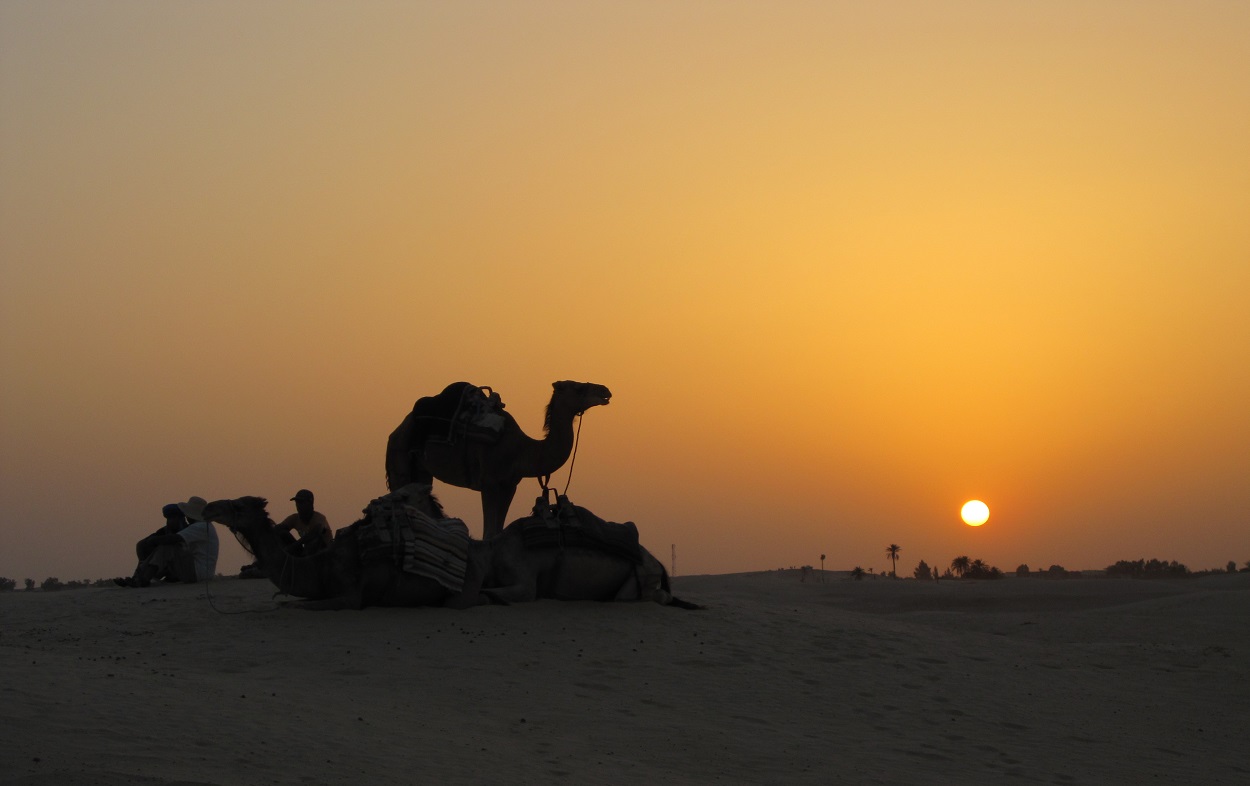Autumn in Tunisia is a period of extraordinary beauty, characterized by a palette of colors that transforms the landscape into a living work of art. The leaves of the trees, ranging from deep green to golden yellow, to shades of red and brown, create a fascinating contrast with the blue sky and the surrounding hills. The oases, in particular, come alive with warm tones, while the olive and citrus groves are cloaked in a mantle of vibrant colors.
Walking through the olive groves and vineyards during this period is a unique sensory experience, where the scent of the damp earth mixes with the fresh, crisp air. Furthermore, Tunisian cities offer enchanting scenery during the autumn. The streets of Tunis, Sousse, and Kairouan fill with life, with open-air markets displaying fresh and colorful produce.
The markets are a riot of colors: oranges, lemons, pomegranates, and dates mix in a mosaic of shades that reflect the richness of the Tunisian land. Walks in the historic centers, with their Moorish architecture and narrow alleys, become even more fascinating when the leaves fall gently from the trees, creating a natural carpet that invites exploration.
Table of Contents
- Introduction: The Colors of Autumn in Tunisia
- Enjoying Tunisian Autumn Cuisine
- Participating in Autumn Festivities
- Excursions in Oases and National Parks
- Visiting the Autumn Markets
- Tasting the Local Wines
- Cultural and Artistic Events
- Relaxing in a Thermal Spa
- Walks Along the Beaches
- Exploring the Archaeological Sites
- FAQs
Enjoying Tunisian autumn cuisine
Tunisian cuisine in autumn is a journey through intense flavors and fresh ingredients. During this season, traditional dishes are enriched with seasonal ingredients like pumpkins, carrots, and legumes. One of the most representative dishes is “couscous,” prepared with autumn vegetables and lamb or chicken.
The preparation of couscous is an art that requires time and patience; the semolina grains are steamed and served with a rich vegetable stew, creating a dish that is both nutritious and delicious. Furthermore, autumn is the ideal time to enjoy hot soups, like “chorba,” a soup made with meat and vegetables flavored with local spices. The combination of spicy and sweet flavors makes every spoonful an enveloping experience.
One cannot forget the “brik,” a crispy pastry filled with egg and parsley, which becomes even more appetizing when served hot. Tunisian restaurants offer autumn menus that celebrate the richness of the local culinary tradition, inviting visitors to discover dishes that tell stories of cultures and traditions.
Participating in autumn festivities
Autumn in Tunisia is also a period rich in festivals and celebrations that reflect the country’s vibrant culture. One of the most important holidays is Eid al-Adha, which marks the end of the annual pilgrimage to Mecca. During this celebration, families gather to share abundant meals and to sacrifice animals as a sign of gratitude.
The streets fill with festivities, with traditional music and dances livening up the atmosphere. Participating in these celebrations offers a unique opportunity to immerse oneself in the local culture and to understand the deep meaning of Tunisian traditions. Another significant holiday is “Mawlid,” which celebrates the birth of the Prophet Muhammad.
During this occasion, cities are adorned with lights and decorations, while families prepare typical sweets like “makroud,” made from semolina and dates. The celebrations also include special prayers in the mosques and cultural events that highlight Tunisian music and art. Participating in these festivities not only enriches the visitor’s experience but also offers an authentic glimpse into the daily life of Tunisians.
Hiking in the oases and national parks

Autumn is the perfect season to explore the oases and national parks of Tunisia, where nature shows itself in all its splendor. The southern oases, such as that of Douz or Ksar Ouled Soltane, offer breathtaking landscapes characterized by date palms and crystal-clear water springs. Walking among the palm trees as the sun sets creates a magical atmosphere, with the warm colors of the sky reflecting on the tranquil waters of the fountains.
These places are not only a refuge for wildlife but also an important testimony to traditional Tunisian life. National parks, such as Ichkeul National Park or Tassili n’Ajjer National Park, offer extraordinary opportunities for hiking and trekking. Ichkeul is famous for its salt lakes and the variety of migratory birds that stop there during the autumn.
Nature lovers can observe pink flamingos and other rare species while enjoying the breathtaking view of the surrounding hills. Tassili n’Ajjer, with its unique rock formations and prehistoric rock carvings, offers an adventurous experience for those who wish to explore the ancient history of the region.
Visiting the autumn markets
The autumn markets in Tunisia are an unmissable experience for those who wish to immerse themselves in local culture and discover unique craft products. During this season, the markets come alive with stalls offering a wide range of fresh produce, aromatic spices, and traditional crafts. Visitors can stroll among the colorful stalls, savoring the scents of local spices like cumin and paprika, while artisans display their skills in pottery and weaving.
In particular, the market of Medina in Tunis is famous for its liveliness and variety. Here you can find everything from handmade carpets to silver jewelry, to hand-decorated ceramics. The atmosphere is vibrant, with vendors inviting passersby to stop and browse their goods.
Autumn markets are not just places to shop; they are also social spaces where people meet to exchange stories and traditions, making every visit an enriching cultural experience.
Tasting the local wines
Autumn is also the ideal time to discover the local wines of Tunisia, a winemaking tradition that dates back to the Phoenician era. Wine regions like Cap Bon offer a variety of red, white, and rosé wines that reflect the country’s unique terroir. During this season, many wineries organize tastings and guided tours that allow visitors to explore the winemaking process, from harvest to fermentation.
One of the most well-known wines is “Muscat,” a sweet aromatic wine perfect for pairing with traditional Tunisian desserts. Other red wines like “Cinsault” or “Syrah” are appreciated for their complexity and structure. Participating in a wine tasting not only offers the opportunity to savor these local products but also allows you to learn from the producers themselves about the traditional and modern winemaking techniques used in Tunisia.
Participating in cultural and artistic events
Autumn is a season rich in cultural and artistic events in Tunisia, where local creativity is celebrated through festivals, art exhibitions, and live performances. One of the most anticipated events is the Carthage Film Festival, which attracts film lovers from all over the world for screenings of independent films and international cinematic works. This festival not only promotes Tunisian cinema but also provides a platform for discussions on social and cultural issues through the language of film.
In addition, local art galleries host exhibitions dedicated to emerging and established Tunisian artists. These exhibitions offer a glimpse into the diversity of artistic expressions in the country, ranging from painting to sculpture to contemporary photography. Participating in these events allows visitors to interact with the artists themselves and to better understand the cultural influences that shape Tunisian art.
Relaxing in a thermal spa
Autumn is also an ideal time to dedicate to personal well-being through relaxing experiences in Tunisia’s thermal spas. The Roman baths of Carthage or the modern spas located along the coast offer regenerating treatments inspired by local traditions. Visitors can enjoy relaxing massages with natural essential oils or immerse themselves in thermal baths enriched with local aromatic herbs.
Tunisian spas often combine traditional techniques with modern approaches to wellness, creating an ideal environment to regenerate after a day spent exploring the wonders of the country. Treatments may include exfoliating scrubs based on sea salt or therapeutic mud from the region’s natural thermal springs. Relaxing in these facilities not only offers a break from the hectic pace of daily life but also represents an opportunity to reconnect with oneself in a serene context.
Taking walks along the beaches
The Tunisian beaches offer enchanting scenery during the autumn, when temperatures are milder and the summer crowds thin out. Walking along the golden beaches of the Mediterranean coast allows you to enjoy the natural beauty of the marine landscape without the frenzy of the high tourist season. Locations like Hammamet or Djerba offer long stretches of fine sand where you can relax in the sun or practice water sports like snorkeling or windsurfing.
Walks along the shore at sunset are particularly suggestive; the sky is tinged with shades of orange and pink as the waves gently lap the beach. Many beach establishments also offer restaurants where you can enjoy fresh local fish dishes while admiring the sea view. This experience not only allows you to appreciate the natural beauty of Tunisia but also offers moments of tranquility and reflection.
Exploring the archaeological sites
Tunisia is famous for its archaeological sites that tell thousand-year-old stories of past civilizations. Autumn is an ideal season to visit historical places like Carthage or El Jem without the oppressive heat of summer. Carthage, the ancient capital of the Phoenicians, offers extraordinary ruins including the famous Punic port and the remains of the Roman theater.
Walking among these historical vestiges allows visitors to immerse themselves in the millenary history of the region. El Jem hosts one of the best-preserved Roman amphitheaters in the world, capable of hosting thousands of spectators in antiquity. Visiting these sites not only offers a glimpse into the greatness of past civilizations but also allows one to understand the cultural importance of Tunisia in the Mediterranean context.
Guided tours often include fascinating stories about the daily lives of the ancient inhabitants of the region.
FAQs
What to do in Tunisia during the autumn?
During autumn in Tunisia you can do various activities, such as visiting archaeological sites, hiking in the desert, enjoying the less crowded beaches, and participating in festivals and cultural events.
What are the main attractions to visit in autumn in Tunisia?
In autumn in Tunisia you can visit the Roman ruins of Carthage, the archaeological site of Dougga, the Sahara desert, the oases of Tozeur, and admire the breathtaking landscapes of the Medina of Tunis.
What is the weather like in Tunisia during the autumn?
During autumn in Tunisia the weather is generally mild and pleasant, with temperatures ranging between 20°C and 30°C. The days are sunny and rain is rare.
What are the festivities and cultural events in autumn in Tunisia?
In autumn in Tunisia there are several festivals and cultural events, including the Hammamet International Festival, the Carthage International Festival, and the Tunis International Fair, which offer shows, concerts, and exhibitions.
What to eat in autumn in Tunisia?
During autumn in Tunisia you can taste typical dishes such as couscous, tajine, brik, lablabi, and desserts made with dates and almonds. In addition, you can taste the local wines and fresh fruit juices.





